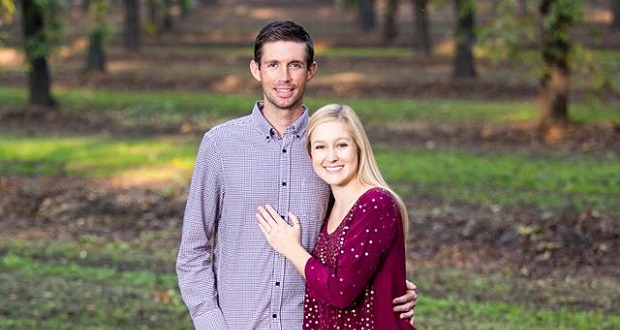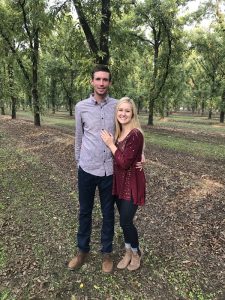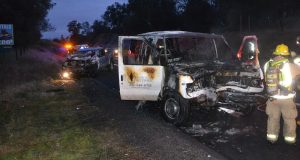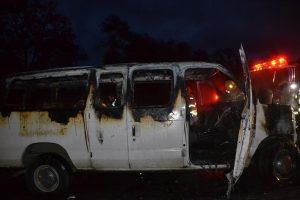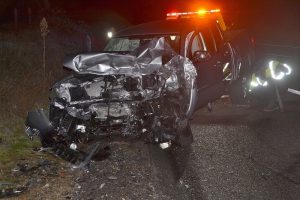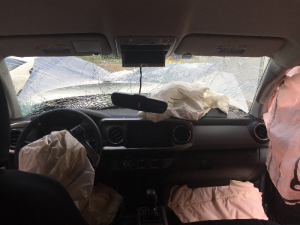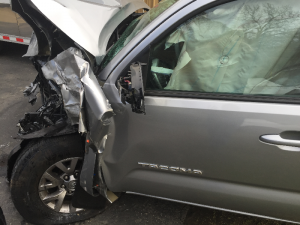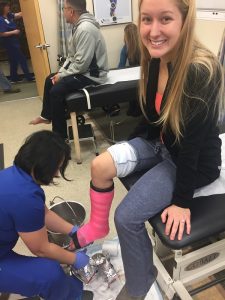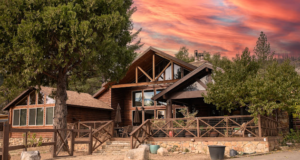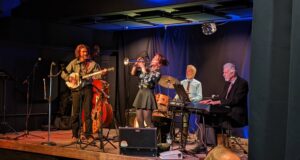“Your life can literally change in a second.”
One minute Jennifer McCaleb and Drew Christenson were commuting down the hill to work, and the next they were fighting for their lives.
The couple met in high school, and had been dating for nearly a decade when they became engaged last February.
Plans for the future were coming together nicely when a recent morning drive to work escalated suddenly into a life-threatening situation.
Neither Jennifer nor Drew are unfamiliar with life-threatening situations; they encounter them regularly in the course of their daily labor.
Jennifer, 26, is a registered nurse working at Community Regional Medical Center in the Emergency Department, where she’s been for a year-and-a-half. Drew, 30, is a helicopter pilot employed at SkyLife Air Ambulance of Central California since 2011.
When their schedules match, they carpool from their home in Coarsegold to work in Fresno. Monday, Dec. 12 was a regularly scheduled work day for Drew. For Jennifer, the decision was more last-minute.
“I received a text from my scheduler requesting if I could come in due to short staffing,” says the emergency room RN. “I thought it would be a good idea and a bonus that I didn’t have to drive and could ride with Drew.”
Heading south on Highway 41 before dawn in their Toyota Tacoma, the couple so familiar with the aftermath of accidents was suddenly involved in one.
“We had only been driving for about 10 minutes and were just North of Road 417,” Jenn says. “It was about 5:40 a.m., so it was dark. It was a clear morning, no fog.”
As Drew drove south on Highway 41, a big truck was heading north hauling a crane. For some drivers that morning, it wasn’t moving fast enough. Drew says he saw a car pass the crane truck coming towards him, and hit the brakes a little just to be safe.
“It was close, but I knew we would be okay,” Drew recalls, though that sense didn’t last long. “Immediately after, we were next to the crane truck and a white Ford E-350 12 passenger van came into our lane to pass the crane truck. They didn’t look first, they just went into our lane.”
Drew says it all happened in an instant.
He told Jen, “We’re getting in a head-on, brace yourself!” The highly trained pilot did his best to avoid the accident, but his efforts were futile. “There was nothing I could do.”
According to CHP at the scene, a Ford F350 van had attempted to pass the slow-moving truck, and crossed into on-coming traffic.
“It happened so fast,” Jen continues, “and it wasn’t just a hit, there were several loud banging sounds; I thought we were rolling.”
She found out later that what she heard was the sound of air bags deploying.
“During all of this, I was really tense and I heard God’s voice command me to ‘be limp.’ I immediately obeyed and I felt myself get thrown around more. After everything came to a stop, Drew said, ‘I’m okay, I’m okay, are you okay? Jen! Are you okay?'”
The two-vehicle crash blocked the southbound lane of Highway 41, with both vehicles coming to rest on the west shoulder of the road. Being a helicopter pilot in the medical field, Drew was well-prepared for an emergency situation such as this one, Jen says, noting that his reactions were quick, yet he remained calm.
“I’ve seen it so many times, I know not to panic,” explains Drew. “I’ve seen accidents like ours and people have died, and accidents much worse and people have lived. We’ve never been in an accident before, but since we’ve seen it so much with our careers, I kind of knew what to expect.”
Immediately on impact, Jen felt excruciating pain in her right foot and hand.
“I was trying so hard to talk, but I was in so much pain and there was so much pressure on my chest that I couldn’t. I let out a whimper and Drew said, ‘Okay good.’ I think the fact that I responded was good enough.”
The driver of the van was able to exit. As Drew quickly evaluated the situation, he saw that the van was smoking and could soon catch fire.
“I knew we needed to call 911 immediately. I knew we needed to get out of the truck and I knew Jen’s injuries could have been life threatening.”
Drew noticed his head was bloody, and immediately covered the wound with his handkerchief, holding pressure to control the bleeding.
“Being calm during chaos is essential,” Jen emphasizes. “Usually we are the ones calming people during crisis, so to be on the other end of things was different. Drew was calm; I was not.”
Just after the Tacoma came to a stop and they realized they were alive, Drew was able to pull his cell from his pocket and call 911 to give their names, exact location, and clear details of what had taken place.
“I remember that he calmly, but urgently, told them we were just in a head-on and to send the helicopters. He told them he was a pilot for SkyLife and I was an emergency nurse at CRMC, and stressed the importance of sending help as quickly as possible. The dispatcher kept asking about the other car and Drew was getting frustrated and told her, ‘I don’t know, all I know is that we are hurt and it’s not good, send an ambulance and the helicopters now!'”
They were trapped in the truck and couldn’t get the doors open. When Drew saw the van was on fire, he quickly reacted and got his knife out of the center console and started popping and cutting the air bags away so he could get out before his truck caught fire as well.
“Meanwhile,” Jen continues, “I couldn’t move, I was trying so hard, but I was in so much pain I just couldn’t do it. I couldn’t breathe. The airbags have some kind of gas or powder and it just made it very difficult to breathe and on top of that have the wind knocked out of you from the airbags.”
Jen lost consciousness while Drew was working to get them out of the truck, and she woke up to a sternal rub.
“That is when someone uses their fist and applies very hard pressure to your sternum and rubs up and down. It is very painful. I barely felt it when I woke up. I knew I was in trouble and immediately went into nurse mode.”
Concerned about the possibility of head trauma, and worried about the hip pain she was feeling, Jen knew her right foot was broken and feared her right wrist was broken too. Before nursing school, Jen had EMT training, which she says really came into play in the minutes, hours and days following the crash.
“At this point I could talk,” she remembers. “I kept telling Drew, ‘I’m okay, but I’m not okay, please help!’ It was awful. I get really emotional when I replay it in my head.”
The only person to stop, according to Jen, was Stephanie Jones, 20, who appeared at the passenger side of the truck next to Drew, asking if they needed help.
“Drew was trying to pull me out of the car and I said, ‘No! No! Wait for the medics to get here, C-spine precautions!”
Then, Stephanie told Jen the other car was on fire, and said she probably needed to get out. Jen was convinced.
“I shouted, ‘get me out, get me out!’ Drew carried me out of the car and laid me down on my back far away from the vehicles. It was freezing out, but it felt so good to breathe in the cold air.”
From her spot on the ground, Jen could see tall, bright orange flames as the van was fully engulfed in fire.
“Firefighters were on scene hosing the van down, so I felt safe. I kept asking, ‘where is the ambulance? what’s taking so long?’ It was about six minutes, but felt like 20.”
Stephanie, the good Samaritan, was right by Jen’s side while they were waiting, holding her hand.
“God bless her. She is an angel. It takes a lot of courage to stop and put yourself in that position of being first on scene. She could’ve came up to our car and found two dead bodies and been traumatized. We are very blessed and thankful she was brave enough to stop and stay by my side while Drew was figuring out what to do.”
Waiting for EMS to arrive, Jen says she was terrified of what she feared may lay ahead.
“I knew I had fractures, but I didn’t know how bad and I didn’t know if I had any internal bleeding. I had the witness, Stephanie, rub both my legs so I could determine if I had a spinal cord injury. Many other people in that situation wouldn’t have thought of that. Working in the medical field, especially emergency, prepared me in the best way it could’ve.”
Jen is quick to note the differences between her job in the emergency department and that of a medic and EMT.
“When patients come into the ED, they are already in C-Spine precautions, they already have their extremities splinted, they already have an IV in place, so when we get them, they have already been assessed and usually, we have a good idea of what needs to be done. We have several resources and diagnostic tools to figure out what is wrong with the patient that we can’t directly see. However, on the scene of an accident, it is just the medic and EMT. They perform a quick head to toe assessment, and get moving.”
Cal Fire Engine 4295 responded along with Madera County Fire Engine 8, Caltrans and Sierra Ambulance. Firefighters quickly got control of the fire, and one-lane traffic control was put in place. Once the medic and EMT arrived, Jen was more than ready to get moving herself, anxious to get the the hospital.
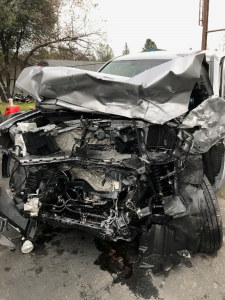 “I was like, ‘it’s time to go, hurry up!’ I knew that I was in trouble, my right wrist and my right foot were swollen and deformed, my left hip was in severe pain. I had no external bleeding, but I was concerned about internal bleeding. I just kept thinking about the worst of the worst we’ve seen firsthand in our line of work and it could’ve easily been me.”
“I was like, ‘it’s time to go, hurry up!’ I knew that I was in trouble, my right wrist and my right foot were swollen and deformed, my left hip was in severe pain. I had no external bleeding, but I was concerned about internal bleeding. I just kept thinking about the worst of the worst we’ve seen firsthand in our line of work and it could’ve easily been me.”
Drew was walking around a lot, which worried Jen, who told him repeatedly that he needed to sit down and be assessed for injuries as well. The couple rode in the ambulance together and were transferred to Community Regional Medical Center trauma bay.
CHP says the F350 was owned by Pacific Coast Tree Experts out of Canoga Park, California. The driver was the only occupant of the vehicle at the time of the crash and was also transported by ground ambulance to CRMC with unknown injuries.
For Jen and Drew, there were plenty of familiar faces on arrival at CRMC.
“Our co-workers, who are also our close friends, were our care providers,” Jen gratefully expresses. “Both Drew and I were relieved to have our friends be in control of our care. We trusted them, knowing their trauma experience. It was terrifying to be in the gurney instead of taking care of the patient in the gurney. There was nothing I could do for myself.”
After careful diagnostic imaging, it was determined that only Jen’s right foot was fractured.
“We were all blown away. Drew was discharged Monday afternoon. I was admitted overnight since I had a concussion and broken foot. I needed a physical therapy evaluation and ambulatory aids. I was discharged late Tuesday afternoon with a walker.”
Jennifer has four broken bones in her right foot. On Wednesday, Dec. 21, the doctor removed a plaster splint and placed a pink cast on her right lower leg and foot.
“They will remove the cast at eight weeks and, if all goes as expected, I should be in an ortho boot for another four to six weeks after that. Other than the foot, I have bruising and swelling to my right knee and right wrist and hand, and bruising and abrasions to my right and left hips.”
Drew suffered a minor cut to his left eyebrow and a black eye, they say, which has healed already. His chest is in a lot of pain still from the airbags and his right ankle is still swollen, but he is able to return to work.
“We are living proof that wearing your seat belt saves your life,” Drew says firmly. “I’ve seen so many accidents that people could have survived from, but they were ejected due to not wearing their seat belt.”
The couple says they feel blessed to be alive, and stress the physical, emotional, and practical preparation than enabled them to survive a potentially catastrophic situation.
“It is essential to be calm when you are in a situation like this,” Jen repeats. “Pray for strength to get through it and to be at peace during the chaos. We are both very grateful for our experiences we’ve learned from work.”
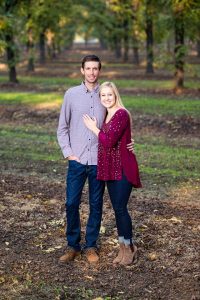 Drew is grateful he was able to access what he needed to free them from the wreckage as a fire burned nearby.
Drew is grateful he was able to access what he needed to free them from the wreckage as a fire burned nearby.
“I think it’s smart to have a knife within reach of your car. What if the seat belts wouldn’t release and we were then trapped in my truck and it was on fire? Luckily I was able to get us out. Also, I’m going to buy a small fire extinguisher and have it in my car because, what if our truck was on fire and we were trapped? It would be horrible to die because we were trapped and I like to think ahead and be prepared.”
There’s an obvious silver lining in this story, and the soon-to-be-married Jen and Drew plan to see that through for all it’s worth.
“Life is something to not take for granted,” the couple says together. “This accident has helped us appreciate the things we have. Things that we thought mattered before, we realize aren’t such a big deal. We are very fortunate to be able to be with our family and friends again. Especially around the holidays, we realize it’s so important to surround ourselves with our loved ones because you never know if and when you’ll get to see them again.”
Read the original story here: https://sierranewsonline.com/head-on-crash-and-fire-on-highway-41/

